Difference between revisions of "224 Palmer St., Wooster, Ohio"
Szimmerman (talk | contribs) |
Szimmerman (talk | contribs) |
||
| Line 1: | Line 1: | ||
| − | [[File:224-PalmerSt.jpg|thumbnail|The | + | [[File:224-PalmerSt.jpg|thumbnail|The concrete block house located at 224 Palmer St. in Wooster, Ohio was likely built between 1893-1895 by Andrew Massaro. It was nicknamed the "Town Hall" of the <em>Little Italy</em> section of Wooster. Photograph by S. Zimmerman]] |
| − | The 2-story | + | The 2-story concrete block house located at 224 Palmer St. was likely built between 1893-1895 by Andrew Massaro. It may be the earliest example of a house in Wooster in which cast concrete blocks were utilized in the construction of a whole house rather than the typical usage of such blocks in the foundation basement walls. Furthermore, the second story features cast concrete balusters to accent the sandstone sill for the double-hung, narrow windows, with round arch heads above. |
| − | The building was originally built to be both a place of business and a residence. The 1896 Wooster City Directory shows that Andrew Massaro & Son operated a grocery store on the first floor and the family lived on the second floor. The imposing | + | The building was originally built to be both a place of business and a residence. The 1896 Wooster City Directory shows that Andrew Massaro & Son operated a grocery store on the first floor and the family lived on the second floor. The imposing concrete store quickly became a central place the local Italian immigrants living in the area, dubbed Wooster's Little Italy, could shop, congregate, and mingle and the building was nicknamed, <em>Town Hall</em>. |
[[File:DrCunningham's2ndAddition.jpg|thumbnail|Andrew Massaro bought lot no. 208 in 1893 as laid out by the plat of Dr. Cunningham's 2nd Addition to the town of Wooster. It was later renumbered as lot no. 1540.]] | [[File:DrCunningham's2ndAddition.jpg|thumbnail|Andrew Massaro bought lot no. 208 in 1893 as laid out by the plat of Dr. Cunningham's 2nd Addition to the town of Wooster. It was later renumbered as lot no. 1540.]] | ||
[[CATEGORY: Palmer St., Wooster, Ohio]] | [[CATEGORY: Palmer St., Wooster, Ohio]] | ||
Revision as of 16:21, 17 August 2015
The 2-story concrete block house located at 224 Palmer St. was likely built between 1893-1895 by Andrew Massaro. It may be the earliest example of a house in Wooster in which cast concrete blocks were utilized in the construction of a whole house rather than the typical usage of such blocks in the foundation basement walls. Furthermore, the second story features cast concrete balusters to accent the sandstone sill for the double-hung, narrow windows, with round arch heads above.
The building was originally built to be both a place of business and a residence. The 1896 Wooster City Directory shows that Andrew Massaro & Son operated a grocery store on the first floor and the family lived on the second floor. The imposing concrete store quickly became a central place the local Italian immigrants living in the area, dubbed Wooster's Little Italy, could shop, congregate, and mingle and the building was nicknamed, Town Hall.

